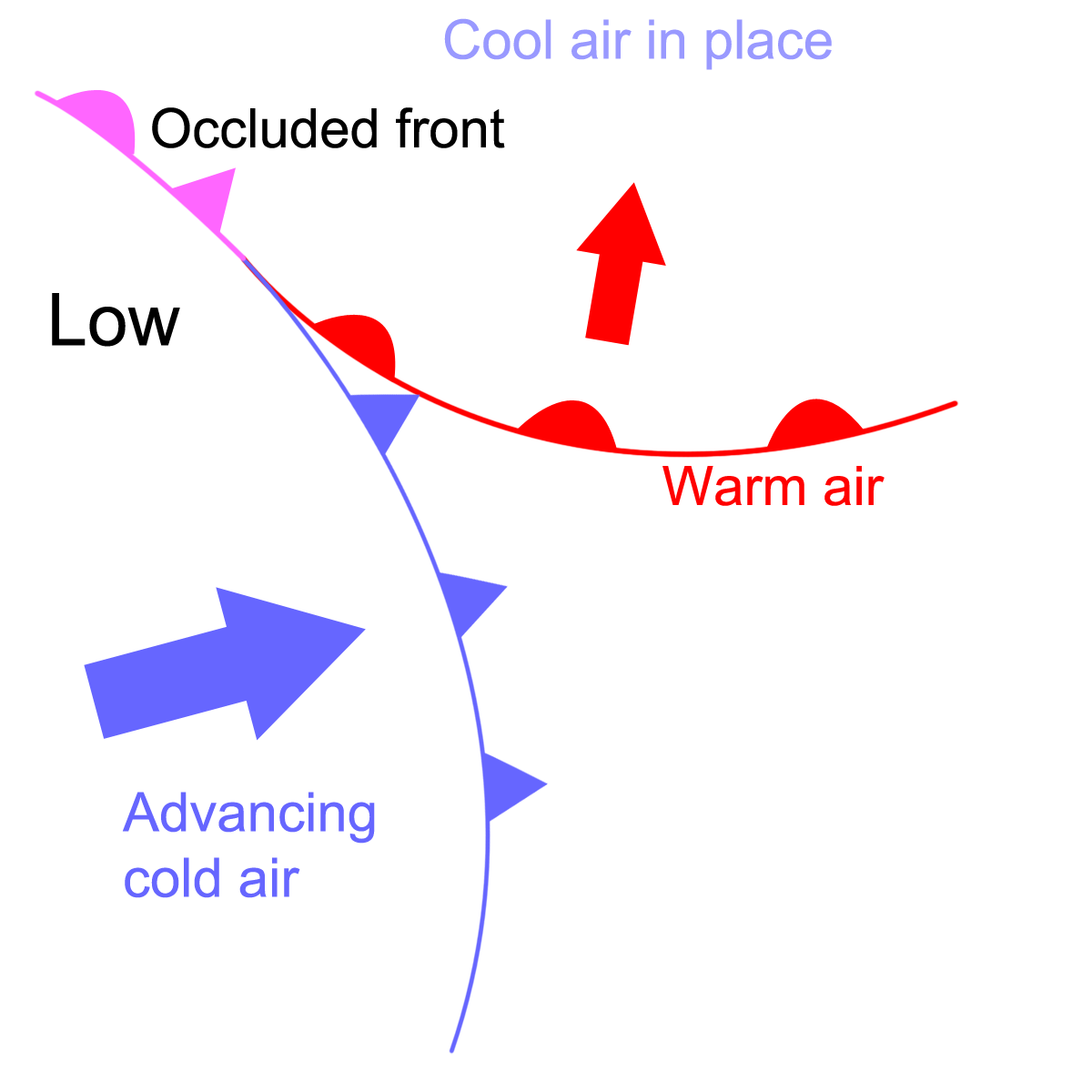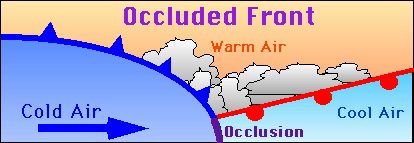Describe the Weather Before and After an Occluded Front
As the front passes the wind changes direction and the temperature heats or cools. Occurs when a fast-moving cold front catches up to a slow-moving warm front.

Occluded Front Center For Science Education
Wind changes direction as the front passes and the temperature either warms or cools.

. On colored weather maps an occluded front is drawn with a solid purple line. When a cold front passes through the weather becomes significantly colder and drier. Wind changes direction as the front passes and the temperature either warms or cools.
It isnt uncommon for air temperatures to drop 10 degrees Fahrenheit or more within an hour of a cold frontal passage Occluded Fronts Sometimes a cold front will catch up to a warm front and overtake both it and the cooler air out ahead of it. An occluded weather front takes place when a cold front overtakes a warm front which is brought upon by a cold front sneaking up behind and moving faster than a warm front. This should be answered using idea.
How are cold fronts and warm fronts similar. There is also an increase in the dew point. Include clouds precipitation temperatures dew point temperatures and wind shifts before and after the frontal passage.
An occluded front involves three 3air masses the other two2. On colored weather maps an occluded front is drawn with a solid purple line. In the map below temperatures ahead east of the front were reported in the low 40s while temperatures behind west of the front were in the 20s and.
A Cold Occluded Front develops when the air behind the front is colder while the air ahead of the front is warmer. Changes in temperature dew point temperature and wind direction can occur with the passage of an occluded front. Ahead of the occluded front temperatures were reported in the low 40s while temperaturesbehind the front were in the 20s and 30s.
Changes in temperature dew point temperature and wind direction can occur with the passage of an occluded front. Occluded fronts are indicated on a weather map by a pinkish-purple line with alternating half-circles and triangles pointing in direction of travel. There is often precipitation along an occluded front from cumulonimbus or nimbostratus clouds.
There is often precipitation along an occluded front from cumulonimbus or nimbostratus clouds. Cumulonimbus or nimbostratus clouds frequently produce precipitation along an occluded front. Occluded fronts usually form.
They are marked on the weather map by a purple line with alternating half-circles and. After the front passes the sky is usually clearer and the air is drier. Occluded fronts usually form around areas of low atmospheric pressure.
What is a pink weather front. Weather forecasters will definitely warn you. Cause persistent weather lasting over 24 hours.
Cloudy rainy or snowy. But the characteristics are highly dependent on the two types of the front. Where is the water warmed.
The newly-formed front brings with it its unique weather conditions. Weather fronts are responsible for the clouds as well as the precipitation. There is often precipitation along an occluded front from cumulonimbus or nimbostratus clouds.
Describe the weather conditions associated with a cold warm and occluded fronts. Describe the path of the water in the loop during winter. The types of clouds that appear during a warm front include Nimbus cumulus and stratus clouds.
In the map below temperatures ahead east of the front were reported in the low 40s while temperatures behind west of the front were in the 20s and 30s. After the front passes the sky is usually clearer and the air is drier. The sky is usually clearer and the air is dryer when the front passes.
If one air mass gains strength or the wind direction change it starts to move again as either a cold or warm front depending on the dominant air mass. The air mass behind the front is. Occluded frontal passages are usually marked gusty winds and bouts of heavy rain perhaps even thunderstorms.
Generally speaking weather conditions generated by his kind of front are light precipitation that can last for days and occasionally fog and snow. An occluded front. Normally either cold or warm fronts dominate.
The temperature may warm or cool. Wind blows parallel to fronts but opposite directions to one another. The temperature within each front is the primary determinant as to the type of frontweather to be expected.
What type of weather does and occluded front bring. A Warm Occluded Front on the other hand develops when the air behind the front is warmer while the air ahead of the front is cooler. Known as dry lines or dew point fronts these weather fronts separate warm moist air masses found ahead of the dry line from hot dry air masses found behind it.
Occluded fronts typically arise around low atmospheric pressure zones. The weather before an occluded front is usually warm and humid. Wind changes direction as the front passes and the temperature changes too.
A stationary front is a frontal system that forms at a fixed location when two air masses meet but neither is strong enough to replace the other. What kind of weather comes before and after an occluded front. After the front passes the sky is usually clearer and the air is drier.
This front is usually characterized by distinct differences in temperature on either side of the front with warmer temperatures on the approaching warm front and cooler temperatures on the approaching cold front. On colored weather maps an occluded front is drawn with a solid purple line. After an occluded front the air is typically drier and cooler.


Comments
Post a Comment